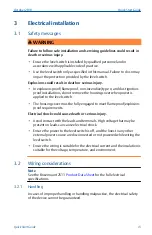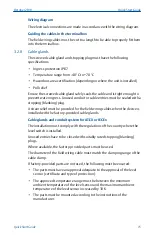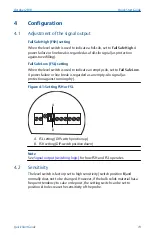
6
Maintenance
6.1
Opening the lid (cover)
Before opening the lid for maintenance reasons, consider the following:
•
Do not remove the lid while circuits are live.
•
Ensure that no dust deposits or airborne dusts are present.
•
Ensure that rain does not enter the housing.
6.2
Regular checks for safety
To ensure robust safety in hazardous locations and with electrical safety, the
following items must be regularly checked depending on the application:
•
Mechanical damage or corrosion of the field wiring cables or any other
components (housing side and sensor side).
•
Tight sealing of the process connection, cable glands, and enclosure lid.
•
Properly connected external PE cable (if present).
6.3
Cleaning
If cleaning is required by the application, the cleaning agent must comply
with the materials of the unit (chemical resistance). Mainly the shaft sealing,
lid sealing, cable gland, and the surface of the unit must be considered.
During the cleaning process, consider the following:
•
The cleaning agent cannot enter the unit through the shaft sealing, lid
sealing, or cable gland.
•
No mechanical damage of the shaft sealing, lid sealing, cable gland, or
other parts can occur.
A possible accumulation of dust on the unit does not increase the maximum
surface temperature and must therefore not be removed for purposes of
maintaining the surface temperature in hazardous locations.
6.4
Function test
A frequent function test may be required depending on the application.
Observe all relevant safety precautions related to work safety (e.g. electrical
safety, process pressure, etc).
This test does not prove if the level switch is sensitive enough to measure
the material of the application.
Quick Start Guide
October 2019
22
Quick Start Guide

















